Status Update: March 2023
Almost no painting and no boardgaming, so I'll focus on RPG and adventure videogames.
Finished
Mass Effect Andromeda
I picked this title in a sale, and was a pleasant surprise. Despite some rough edges, repeating mechanics and still some weird character faces (the game features a lot of procedurally generated content, but has improved from the initial release), story-wise it felt different and refreshing, and I enjoyed a lot some of the teammates and their side-quests.
You also get to visit quite a few worlds with nice variety and great level design, and being a different story helps to provide different adventures. There are also quite a few boring "filler" quests, But there is enough content and pseudo-mini-games that I registered more than 50 hours before the ending.
Highly recommended for Mass Effect fans, as for now there's nothing else in the horizon.
Mass Effect Legendary Edition (1st game)
I wanted to revisit commander Sheppard's adventures, so I also got the Legendary Edition trilogy with a nice discount, and, after ME Andromeda, decided to replay the first title (for the 3rd or 4th time). Despite of the graphical improvements, it begins to feel the weight of time, especially regarding scenarios: Most non-critical side-quests reuse even the same maps with different generic prop placements; the scenarios feel big and vast but really empty; and the Mako sections (a land vehicle you drive and shoot from) have improved but are still dull and become really boring by the end of the game.
And yet, story-wise is still awesome, as it is playing as a purely evil character (a "renegade"), solving most situations in a badass but funny way, often involving fighting. Later titles became less appealing in regards to the main story, although secondary quests were the best I can remember; ME1 originated everything and it still feels to me like one of those classic sci-fi movies that you can re-watch from time to time, never getting tired.
Ongoing
Valheim
Ongoing, slowly progressing as I read tiny bits of initial strategies and learned that my initial world seed was not very too good, but thankfully you can travel "between worlds". So I could move the character and inventory to a more suitable one, with more varied biomes, more terrain, and less tiny island-like.
The setting of the game is really good, but at the beginning the "survival" part is your real challenge. And I'm loving the norse mythology vibes.
Xenoblade Chronicles 3
Dreading the insanely long previous playtimes to feel you are advancing, I don't know why I almost parked this title. Well, actually I also think that the heavily scottish-like accents, while not new to the series, had something to do. They are very noticeable because the first hours involve a lot of talking between many different characters, many of them with the accent. Plus some weird stuff that I don't yet know what it means (no spoilers).
Still, pushing my way through slowly as I guess the remaining folks I'll meet will be more "generic English" voiced. It will probably be my main RPG target for the following months as I'm eager for the story and how it fits with the previous titles.
New
Conan Exiles
As if one survival game (Valheim) wasn't enough, I went and picked another one! Also just began playing it so it's still early to form a reliable opinion. Your first steps are quite hard (dying of thirst, hunger, or killed by any human I find), and so far I've been just learning to survive, and chopping trees and rocks to be able to build a (tiny) house. Everything requires a lot of materials and breaks so soon!
The hugely varied crafting system is what lured me into this title, so let's see how it evolves. It also looks to contain a huge world to explore.
Hogwarts Legacy
Just began playing this one. Planning to take it slowly, as I like the movies and world lore but I'm not a real Potterhead.
Tags: Videogames
Book review: The Thing
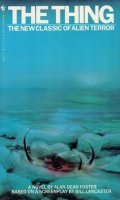
The Thing is one of my all-time favourite movies. After watching it again recently, I spent hours inside IMDB's trivia and fact sections, and when one comment mentioned "the novel", I had to dig deeper. I then found not only that there is a novel about the movie, but the even more interesting fact that the novel is based on the movie script, but not on the movie itself. This means that there are a few differences between both, making the book a nice addition. After reading it, here are my thoughts.
First of all, the book contains way more dialogue and background details about the party members. In some cases would still feel like redundant information in the movie, but at times the dialogs provide better explanations, like why folks act as they do, or we learn that Macready is a Vietnam veteran (not just a badass pilot). I must say that the movie still was able to compress and distill the most relevant parts of the conversations, it is still quite comprehensible. Just not as detailed.
There are also a few scenes totally missing from the film and a few others that were shortened, especially during the second half of the book. The last chunk, without spoiling anything, is very similar in concept, but with a few notable changes in execution.
And of course, there are a noticeable amount of changes: While "the thing" in the movie is very shape-changing, the book tends to attempt to revert to its original form (or at least a preferred form), resulting in many of the scenes involving the creature playing differently. The expedition voices way more of their thinking on how they guess the monster thinks and acts, providing more context on why they later do other actions. MacReady's character feels a bit different too, maybe having too many angles inside a not-too-long book (around 200 pages).
Overall, the reading felt like a very curious experience, something very familiar and known, and yet new and different. Recommended if you enjoyed the movie.
I wonder if there are more similar cases of books written before the movie was filmed...
Tags: Books
Book review: Snow Crash
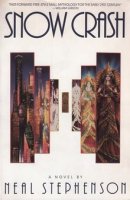
Now that the metaverse is one of the most trending buzzwords, I wanted to read "the source" of the "connected virtual online universe" concept, so I decided to pick and read Snow Crash, from Neal Stephenson. After reading it... the word that best summarizes my opinion is "disappointment".
I must confess that I came hyped. After reading Ready Player One and, more recently, Neuromancer, I was ready for some cool virtual world geekiness. What I found is a futuristic world with a weird mixture of technological concepts, humour, action and bizarre ideas, and only the first one felt (mostly) nice.
Sometimes, reading certain technological ideas I'm amazed that the book was written in the early nineties. It presents really well the idea of an alternate 3D virtual world, ruled by code algorithms and connection bandwidth, with avatars, digital currencies, and other concepts that have materialized, albeit in different forks. Concepts like requiring more processing power to render complex effects in the metaverse, being able to cheat the physics laws and security measures because everything is governed by code, and even "coders and hackers" being a highly valued workforce are correct. But other times you feel the author just grabbed some technical term and applied it without any real research about its meaning. Still, the tech part is more than fine and really what merits going through the whole book instead of discarding it.
The humour... kills me. I'm perfectly fine with sci-fi movies containing non-trivial doses of humour (e.g. Demolition Man), but here too often I found myself thinking "WTF...". The book basically alternates between adventures in the real world and the metaverse, and almost everything that happens in the real world felt either stupid or uninteresting. And the names of the characters and real world references are also quite dumb... "Hiro Protagonist", "Y.T." (from "Yours Truly"), all the pizza delivery nonsense...
The action is mostly absurd, combining super-hero like characters (e.g. "the best swordsman in the world") with opportunistic situations and boring scenarios. I don't understand how, with all the potential plots that could come (and have appeared in literature, movies and games both after and before) the real world story is so decaffeinated.
And the bizarre ideas... without entering in any spoiler, the whole "snow crash" concept is the biggest WTF. When I first learned what it refers to, I almost stopped reading the book, because it felt such a dumb concept, and kind of cheat to try to make the plot more interesting. It is also embellished with pages and pages of descriptions of the origins, and paragraphs and paragraphs of an explanation by the main protagonist when he fully understands it, up to the point that feels as a justification of why such a "concept" is real (in the book).
I wanted to believe. I was ready for a nice ride. But instead I found some very cool ideas almost buried by a poor plot. I only recommend reading this book if you wish to research about the source of the metaverse and/or player avatars.
Tags: Books
Status Update: November 2022
LOTR Vol. II
It took me time, but I finished J.R.R. Tolkien's The Lord of the Rings, Vol. II - The Two Towers. The first one looked quite similar to the movies, while this second instalment departs at times quite noticeably from the movies and books (at least what I remember of them). I directly went to use a guide, and while I enjoyed the back and forth between the multiple storylines and you can feel that the game engine now was known and better used (more battles, bigger maps), it felt weaker than the first title.
Elden Ring
Unpopular opinion: I abandoned the game. I feel the lore and plot is just a spaghetti of miscellaneous concepts with a thin thread keeping most of them together, and the game demands too much of my time only to enjoy. I love pouring hours in games I have fun with (nearing 200h in Zelda BOTW, hundreds at each Diablo game, etcetera), but I don't enjoy being punished and sometimes cheap-killed frequently. So after 30h of gameplay, just shelved it. Not for me.
Baldur's Gate: Dark Alliance
After having finished it a few times in Playstation 2 and once in the Nintendo Switch, now I have it on PC and also have finished it once 😆
Castles & Castles II
I've loved medieval history since I was a child, so the early nineties franchise Castles offering me a chance to build and maintain castles "the way I liked" was so appealing. I went and played one campaign of each, and re-watched all the Castles II documentary videos, although the video compression is quite ugly nowadays.
Assassin's Creed: Valhalla
I love how Ubi Soft try to respect history, while twisting details to simplify gameplay. In AC Valhalla you will notice it more frequently because the vikings were all but peaceful folks, so you can do viking raids but they are a decaffeinated version (mostly focused on combat and looting). Still they are a nice addition, and the boat travels, fights and all-things-related feel amazing.
What got me tired of the game is the usual Ubi Soft mechanics: You have so many primary quests, secondary quests, optional quests, side-quests, fetch quests, treasure quests and who-knows-what-else quests, that you burnout easily, because in the end gameplay mechanics are what they are: An assassin jumping, sneaking and killing people. So after around 40h, the game tells me I have finished barely around 30%, so I need to to take a break before I abandon it permanently.
It is really amazing visually, and fun to play, it simply gets tiring and should be smaller in missions scope.
Xenoblade Chronicles 3
The third instalment came out on Nintendo Switch, so I'm slowly warming up to pour in the dozens of hours that each new title in the saga takes. The beginning is a bit slow, but it is too early and fans of the series praise the plot so let's see what awaits!
Valheim
More Nordic mythology reading, plus stopping playing AC: Valhalla made me crave for some other "viking themed game". I visited a videogame museum that mentioned the early access title Valheim, and I already had my sights on it, so decided to purchase it and play. It is a survival crafting game (but with a purpose and I think a real ending if you pursue the plot), so I'm still struggling to survive in my small fenced house, while I improve my skills and learn how to craft better tools and equipment to face my first enemy boss, but the game is really fun: you need to build the houses following the old nordic ways, having a fire inside to keep you warm but at the same time letting the smoke go out (or you will choke), structures have weight and pressure, and the pixelated textures 3D engine is actually quite pleasing visually.
Boardgames
On the boardgames side, me and my partner began playing some not too complex boardgames from time to time, so I decided to purchase a very simple dungeon crawler, Karak. We've played a few games and, while it indeed has simple mechanics, is really easy to get into and fun for everyone.
Tags: Videogames
Comic Book Review: Aliens Omnibus 1 to 6
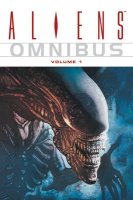

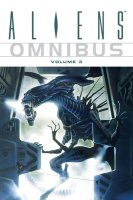
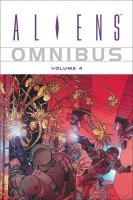
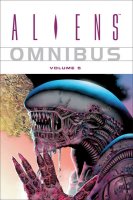

I've always loved Aliens. They made me had nightmares when I watched the movies as a child, but I loved them. I would build LEGO bases and vehicles and imagine my characters had to survive xenomorph attacks. I had some metal painted miniatures, and played every Arcade and that licensed or was inspired by the movies. And I had since long pending to read the six Aliens Omnibus volumes.
Vol. 1 is a bit long and sometimes bizarre, with too much effort put on keeping present the original (surviving) characters from Aliens movie. But a few of the shorter series had a pass, so not terrible.
Half of Vol. 2 is Colonial Marines, a huge mashup of loosely connected sub-stories, under a common setting and plot. At times I felt there were missing pages due to the sudden narrative changes, jumping to an unknown character that we briefly see during two pages to never be heard of again afterwards. I also probably didn't liked it too much because it breaks the "xenomorph science" rules, stretches and the royal jelly concept too far for my liking.
And then everything gets even worse: Too many comics along the whole Omnibus series have too weird, surreal and sometimes even directly disgusting plots. Once they came up with the "royal jelly as drug" concept, all sorts of twists around the concept are used over and over, as the basis for otherwise weak stories. Also to be noted that the usage of iconic guns, spaceships and APC tanks in some cases is nice, but in general is over-abused, up to the point that Earth has been almost destroyed and re-created (way after the first two Alien movies), humanity seems to have advanced, and yet they keep using almost the same ships, vehicles and weapons.
To be sincere, when I was at the sixth and last omnibus, I skipped more than half of it. skimming through the pages or checking the first ones of each story were enough to detect that quality didn't improved, so I decided to not waste my time.
I feel deeply disappointed. Predator Omnibus felt dull and repetitive at times, but Aliens Omnibus is directly bad, excepting a few very specific mini-series.
Tags: Comics